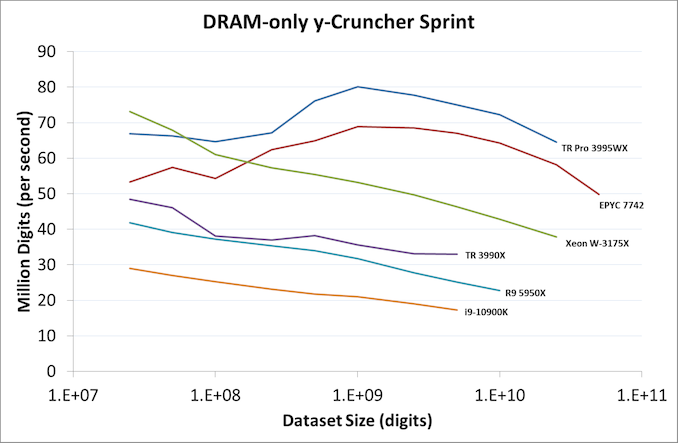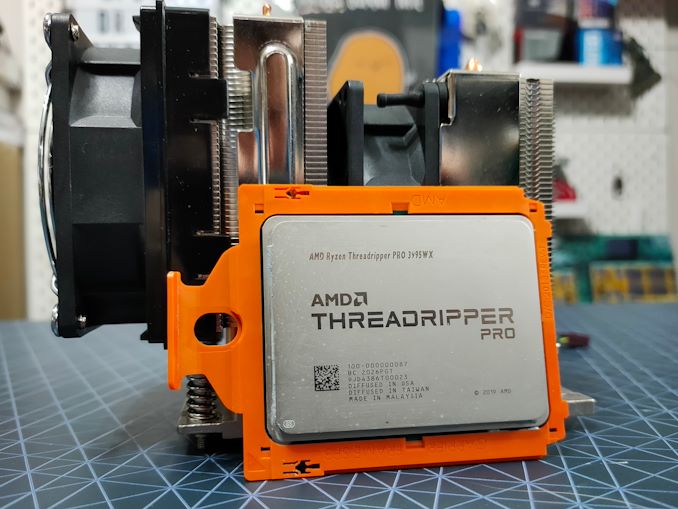Lenovo ThinkStation P620 Review: A Vehicle for Threadripper Pro
by Dr. Ian Cutress on February 16, 2021 9:30 AM ESTDo It For The Bits
With a review of an OEM system, it can be sometimes hard to separate the conclusion on the hardware from the system itself. Inside a laptop, it’s a lot easier, as the OEM can combine a number of things into a small chassis and optimize for performance – on the desktop and workstation side however, there’s usually not so much to budge on performance, although design, thermals, and acoustics all come into play. The review has to end up focusing a lot on the value, performance per dollar, and build quality, and any extra bells and whistles. Luckily for Lenovo ThinkStation P620, the focus isn’t so much on the price, but all those bells and whistles.
The ThinkStation P620 system that Lenovo sent us was the company’s first ever AMD ThinkStation platform. It was set up with the top end AMD Threadripper Pro 64-core processor, a beefy NVIDIA RTX 6000 GPU, and some solid storage. Taking advantage of the platform, Lenovo put 80 lanes worth of PCIe connectivity in out of the 128 offered by the processor, as well as 512 GB of memory support through eight memory channels. The fact that Lenovo only sent a review unit with two memory sticks is an unfortunate $200-$400 saving on a $20000 review sample and really hurts the performance in some of the tests on the CPU, but to see the full 8-channel results, head on over to our dedicated CPU review. Memory aside, Lenovo has a lot going on in this system worth talking about.
A lot of off-the-shelf systems take standard PC parts and put them together. The size and skill of a company like Lenovo means that they don’t have to do that, and we get designs like the P620. Lenovo has a fully custom motherboard just for this product line, and it uses an ultra-special power supply that has zero power output cables. Lenovo has designed the system such that the PSU plugs into the motherboard like a standard connector, and all 1000 W goes to the rest of the system through the motherboard rather than cables. This means the motherboard has to be designed to take care of all that power, but it reduces the overall size of the system without the need to route cables (the whole design is 33.4 liters, rather than 70+ for a modern high-end PC), and makes the power supply so easy to remove, upgrade, replace, and all that. It is very obvious how deep the design goes here.
On to that, the system also has a PCIe bracket area that is both tool-less and easy to use, and the PCIe card is fixed in with an external stiffener which effortlessly blends in with the rest of the system. The two M.2 slots are built into the motherboard and perhaps more difficult to access, with our system having one of them populated with a 512 GB WD SN530 drive. There are also four 3.5-inch bays for dedicated storage in the bottom of the chassis. Two of the PCIe slots are also aimed at storage add-ins, such as the M.2 riser cards now available.
Lenovo lavishes on the USB 3.2 Gen 2 (10 Gbps) support with eight ports total, four on the front panel, and two of those being Type-C. Networking is through a copper 10 gigabit connection, with options for more advanced connectivity through the PCIe slots. To help out with debugging, there’s a four-digit display on the front panel that turns off after a successful boot.
Another nod on design here – the CPU cooler uses a differential height dual tower design, and the full retail system is designed to have an air baffle between the top and bottom areas, enabling for cooling zones. Cooling on this system is really nice, with the lowest fan setting and a sustained 24-hour CPU+GPU load putting the CPU at 78ºC and GPU at 81ºC. The system was warm to touch on the top, but nothing out of the ordinary. The full system power draw, with the 64-core AMD and RTX 6000, came to 640 W.
For the processor, performance on AMD’s Threadripper Pro 3995WX was a few percent higher than the standard Threadripper 3990X in our testing, with the eight channels of memory offsetting the slightly lower CPU frequencies. Our system observed 4200 MHz on single core turbo, 4000 MHz when up to 20 cores are active, and a sliding scale down to 3100 MHz on all cores when at full tilt. The +3% performance uplift isn’t enough to change the +$1500 list price of the processor, because ultimately that extra cost is going into the features, such as more PCIe 4.0 lanes, higher memory capacity, and professional-grade system administration through a Pro platform, most of which the ThinkStation P620 enables, along with a stellar chassis design.

Benchmark from our 3995WX CPU Review, showing 8 Channel Performance
It’s hard to judge a system without a price, but we have to ignore the prices on Lenovo’s website – the company has told me in the past that less than 5% of workstation sales happen like that, and the website only limits a user to five units. Most ThinkStation P620 sales happen through the B2B channels, where a visual effects company orders a few dozen for its artists and designers, perhaps gets a discount, but also enables Lenovo’s pro service and warranty packages. This usually includes replacement machines if one needs to be returned and things like that.
Take this recent Linkedin post from a product manager at Lenovo, showcasing another visual effects design studio that purchased a dozen 64-core variants of the Thinkstation P620 after some initial testing.
At this time Lenovo has the exclusive on Threadripper Pro, and so the P620 is the only option in the market. It’s a really nice option, and for those that need it, it surely fits the bill. There are going to be a number of OEMs coming out later this year with their own TR Pro systems when the exclusivity expires, but they will mostly be using off-the-shelf motherboards. Lenovo’s design is unique, and has hallmarks of design ideas I’d love to see in the industry at large. I don’t see much going wrong for a user that has to use one of these systems. Just make sure it’s got eight memory sticks. Please. Do it for the bits.














47 Comments
View All Comments
Billy Tallis - Tuesday, February 16, 2021 - link
Since Lenovo offers extended warranties out to five years for surprisingly low prices, it's reasonable to assume they'll be able to provide compatible replacement PSUs for at least five years past when they stop selling this machine. That's long enough to make this a non-issue in a corporate environment, even if it may hurt the secondhand market for these machines.Calin - Wednesday, February 17, 2021 - link
People that pay $20,000 for such a workstation will replace it in a couple of years with something better. However good this Threadripper Pro workstation is, five years from now it will be a dog (well, at least compared to another $20,000 workstation).I don't really see this level of performance being enough for more than about 3-4 years, and a well designed power supply will certainly last more than that.
DanNeely - Tuesday, February 16, 2021 - link
I think I've only had 1 PSU fail in waranty over a dozenish self built PSUs over 20 years. The failure wasn't with the AC-DC hardware but the pins on the modular interface to attach one of one of the PCIe cables getting pushed into the PSU and no longer making contact.Other than that every PSU I've owned has lasted at least 7 (or more recently 10) years before failing. Most of them were in environments of 24/7 full CPU/GPU loads from distributed computing. Granted I don't buy cheap PSUs (at high continious load gold/platinum models increased efficiency actually does pay for itself over the life of the PSU). OTOH I doubt Lenovo is using low quality units in systems this expensive either.
Calin - Wednesday, February 17, 2021 - link
While you might buy very good quality PSUs, in such flagship workstations Lenovo will put only the best power supplies money can buyHul8 - Tuesday, February 16, 2021 - link
Really appreciate the rickrolling in these recent TR Pro articles. Always brings a smile.Smell This - Tuesday, February 16, 2021 - link
I asked for the base ThinkStation P620 Tower Workstation (xxxx FH00) and pulled the trigger ... my CC only has a $1,800 limit so Martin at Lenovo RTP hooked me up to the interest-free payment plan. LOL Suckers. HA! (j/k)
Configuration Details
● Processor: AMD Ryzen™ Threadripper™ PRO 3945WX Processor (4.0 GHz, up to 4.30 GHz Max Boost, 12 Cores, 24 Threads, 64 MB Cache)
● Operating System: Windows 10 Pro 64
● Memory: 32 GB DDR4 3200MHz RDIMM ECC (2 x 16 GB)
● Hard Drive: 512 GB M.2 Gen 3 PCIe SSD, OPAL
● Graphics: NVIDIA® Quadro® P2200 5GB
● Optical Drive: DVD-RW
● Form Factor: Tower
● 1000W Fixed 92% Autosensing, 80 PLUS Platinum qualified
● Network Card: Integrated Ethernet
● Key lock: Key Lock Kit w/ Common Key
● Keyboard: USB Traditional - US English
● Pointing Device: USB Optical Mouse
● Memory Card Reader: 15 in 1 Card Reader
● 4Y Premier Support Upgrade from 3Y Onsite
The 4-year support upgrade was a condition of the financing. The onboard 10 GbE is the Marvell AQtion AQN-107. The Quadro® P2200 5GB was a nice bump but no NV link.
The 32 GB DDR4 3200MHz RDIMM ECC (2 x 16 GB) would appear to be the minimum. Didn't leap at the PCIe 4.0 NVMe 'upgrade.' I've used Lenovo keyboards before -- they're solid but maybe a little 'mushy' (not a great typist, anyway)
Grand total: $2,423.18 with NC sales tax, shipped to my door -- gave me an additional $1,000 credit with $100-off on my next purchase.
Smell This - Tuesday, February 16, 2021 - link
Link
https://www.lenovo.com/us/en/think-workstations/th...
bobsmith1492 - Tuesday, February 16, 2021 - link
Very nice. You can customize and add 8 channels of RAM. I've been planning a Threadripper build and their configuration with the recent coupon is pretty reasonably priced compared to a custom build.Smell This - Tuesday, February 16, 2021 - link
I'm hoping a standard modular GPU cable(s) will work!
I'm thinking Rendering/Encoding with GPU compute in Vegas may not need the umphh of that 8-channels of RAM but we shall see. Maybe 4-channel 4x16GB could be a nice compromise.
It may be of benefit using scratch drives in Adobe, but I try to avoid the big "A" for the most part. I'm heading toward a down-clocked RX Vega 56, or even a Fury on AMD Radeon Pro software, depending upon that Quadro P2200.
TanelPoder - Tuesday, February 16, 2021 - link
It’s an excellent machine. Thanks to the 128 PCIe lanes, 4 PCIe root complexes and 8 memory channels, I got over 11M IOPS and 66 GiB/s scanning rate out of it (I used 10x Samsung 980 PRO SSDs with quad PCIe-M.2 adapters) for it.For anyone interested, here’s an article about it:
https://tanelpoder.com/posts/11m-iops-with-10-ssds...